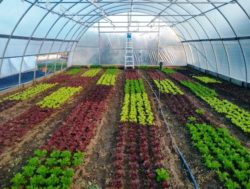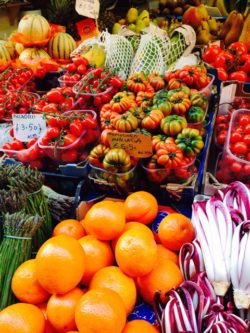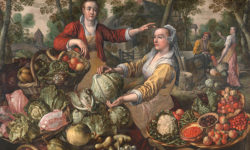Read Time: 5 Minutes Subscribe & Share
Hoe Vs. Plow
 A chance remark made by a market gardener at his stand started the trail of this post. He asked me if I knew
A chance remark made by a market gardener at his stand started the trail of this post. He asked me if I knew  that Paris was at one time fed primarily by market gardens — the small plots that fuel so many of our farmers’ markets. And no, I did not. One of my favorite things to do when I visit another city is to shop in food markets that are not grocery stores and (if we have a kitchen) purchase provisions to make a meal. And most of them have a rich history of market gardens behind them. The Borough Market in London, Union Square Green Market in New York City, Pike Place Market in Seattle are just three examples. It made me curious about the rise and fall (and, we hope, the rise again) of US market gardens. Historically, they were harbingers of small business success, a necessity for burgeoning urban centers. Their decline in the US precipitated the food desert issue, along with monoculture farming — the unsustainable approach to providing healthy food for our population. Usually market gardens are around an acre (although they can be as much as 10 acres). Originally market gardens were distinguished as being cultivated with a hoe, while on farms, the land was cultivated by a plow. An acre itself was determined by the amount of land that could be tilled by a pair of oxen and a plow in one day. Interesting side note from Wikipedia: The word ‘truck’ in truck farms does not refer to the mode of transport, but rather from the old north French word troquer, which means “barter” or “exchange”.
that Paris was at one time fed primarily by market gardens — the small plots that fuel so many of our farmers’ markets. And no, I did not. One of my favorite things to do when I visit another city is to shop in food markets that are not grocery stores and (if we have a kitchen) purchase provisions to make a meal. And most of them have a rich history of market gardens behind them. The Borough Market in London, Union Square Green Market in New York City, Pike Place Market in Seattle are just three examples. It made me curious about the rise and fall (and, we hope, the rise again) of US market gardens. Historically, they were harbingers of small business success, a necessity for burgeoning urban centers. Their decline in the US precipitated the food desert issue, along with monoculture farming — the unsustainable approach to providing healthy food for our population. Usually market gardens are around an acre (although they can be as much as 10 acres). Originally market gardens were distinguished as being cultivated with a hoe, while on farms, the land was cultivated by a plow. An acre itself was determined by the amount of land that could be tilled by a pair of oxen and a plow in one day. Interesting side note from Wikipedia: The word ‘truck’ in truck farms does not refer to the mode of transport, but rather from the old north French word troquer, which means “barter” or “exchange”.
The Ugly Relative Of Ornamental Gardens
 A market garden was vastly different from a medieval farm, which usually incorporated livestock, fields of grain, and orchards, and in much of early European history, were “leased” – meaning that the farmer turned over a large percentage of his yield to the landowner. Malcolm Thick, a British historian on agriculture and gardening, wrote that the much smaller market gardens were the “ugly sisters of garden history”. In a sense, they were viewed as unsightly compared to the beautiful designs for the ornamental gardens of Catholic cloisters or wealthy nobles. Small and intensively cultivated by hand, producing just fruits and vegetables, market gardens were spotted with cloches, rickety trellises and untrammeled vines. This mix of garden and commerce had its earliest roots in 13th century Europe, where urban populations grew outside the original fortified cities and towns. By the 17th century, in The Netherlands, which was a hotbed of early capitalism, market gardens rose to prominence due to the shortage of arable land in this sea-bound country where transportation by canal made this an easy way to provide food at a profit to urban centers. Discoveries of new fruits and vegetables through voyages to the Far East and the surprise of a vast continent between Europe and Asia, greatly expanded what these small gardens could supply their urban customers – and ultimately changed the appetites and cuisines of these countries. A devastating famine at the end of the 16th century in London created the Perfect Storm moment for market gardens to flourish to feed this ever growing city (not to mention the plenitude of fertilizing excrement from the thousands of outdoor privies).
A market garden was vastly different from a medieval farm, which usually incorporated livestock, fields of grain, and orchards, and in much of early European history, were “leased” – meaning that the farmer turned over a large percentage of his yield to the landowner. Malcolm Thick, a British historian on agriculture and gardening, wrote that the much smaller market gardens were the “ugly sisters of garden history”. In a sense, they were viewed as unsightly compared to the beautiful designs for the ornamental gardens of Catholic cloisters or wealthy nobles. Small and intensively cultivated by hand, producing just fruits and vegetables, market gardens were spotted with cloches, rickety trellises and untrammeled vines. This mix of garden and commerce had its earliest roots in 13th century Europe, where urban populations grew outside the original fortified cities and towns. By the 17th century, in The Netherlands, which was a hotbed of early capitalism, market gardens rose to prominence due to the shortage of arable land in this sea-bound country where transportation by canal made this an easy way to provide food at a profit to urban centers. Discoveries of new fruits and vegetables through voyages to the Far East and the surprise of a vast continent between Europe and Asia, greatly expanded what these small gardens could supply their urban customers – and ultimately changed the appetites and cuisines of these countries. A devastating famine at the end of the 16th century in London created the Perfect Storm moment for market gardens to flourish to feed this ever growing city (not to mention the plenitude of fertilizing excrement from the thousands of outdoor privies).
The Rise Of The Maraîchères

 To make these ugly sisters even less attractive, market gardeners added to the unsightly paraphernalia to extend the growing seasons of these highly productive plots. The 17th and 18th centuries saw enhancements to primitive cold frames come into being. These improvements led to the fabled reputation of the Parisian version — the maraichères which had developed into small economic powerhouses beginning in the 17th century and continuing throughout the 19th century. According to Elliot Coleman, who has helped to spearhead the resurgence of market gardens in the US, six percent of all the land in Paris was in the hands of these maraichères , as well as the surrounding marshlands which had earlier been filled in (some with ornamental gardens). With their advanced glass cold frame designs (the predecessor of our 21st century hoop houses and tunnels) and the use of manure to heat as well as fertilize crops under glass, Parisians were able to purchase salad greens in January or cucumbers and melons in early summer. And in the 21st century, maraicher gardens are on rooftops as well as reclaimed swamps.
To make these ugly sisters even less attractive, market gardeners added to the unsightly paraphernalia to extend the growing seasons of these highly productive plots. The 17th and 18th centuries saw enhancements to primitive cold frames come into being. These improvements led to the fabled reputation of the Parisian version — the maraichères which had developed into small economic powerhouses beginning in the 17th century and continuing throughout the 19th century. According to Elliot Coleman, who has helped to spearhead the resurgence of market gardens in the US, six percent of all the land in Paris was in the hands of these maraichères , as well as the surrounding marshlands which had earlier been filled in (some with ornamental gardens). With their advanced glass cold frame designs (the predecessor of our 21st century hoop houses and tunnels) and the use of manure to heat as well as fertilize crops under glass, Parisians were able to purchase salad greens in January or cucumbers and melons in early summer. And in the 21st century, maraicher gardens are on rooftops as well as reclaimed swamps.
Whither the US Market Garden
Market gardeners in the US during the 20th century had a tough row to hoe (terrible pun, but the phrase is apt). If you think about it, the first half of that century was plagued by war on a global scale. In the US, all was geared to production – machinery and food. Factory production on an agricultural level found a new home with the American consumer. The US became the poster child for convenience foods, long shelf-life and cheap pricing, made possible by farm subsidies (paid by tax payers) to ever more monolithic industrial farming companies. Even school lunch programs, which were once highly localized, were forced into Federal compliance that was designed by these same companies. We all recall the designation of ketchup as a vegetable. I remember shopping at my local farmers’ market and watching the small farm stalls slowly disappear, so that the square became a craft market with some foods as garnish. The light at the end of the tunnel is a generation of new market gardeners, who have enriched and expanded farmers’ markets in urban centers across the US. Market gardens serving restaurants are now featured on menus, something I never remember seeing 40 years ago. A unique feature of US and Canadian market gardens are the C.S.A. programs, in which farmers line up subscribers who pay up front to receive timely boxes of whatever is currently being harvested. And there now is lots of help available from independent market garden groups and state agencies or university agricultural departments. When you want some good news videos, click on to Farmers Friend, which produces equipment for market gardens. It’s my happy place.

Kitchen Detail shares under the radar recipes, explores the art of cooking, the stories behind food, and the tools that bring it all together, while uncovering the social, political, and environmental truths that shape our culinary world.




Oh, what a tonic you are, Nancy! I love every single post, but this one really resonated. The video was a welcome bonus on this rainy, locked-down day. A beautiful reminder not only of how differently delicious is homegrown food, but of how far we strayed from this ideal, only to come full circle to our past.
Thank you so much for this. Keep ‘em coming!
Hello Janet,
What a lovely note to send us! It means a lot when we hear from readers like you. I really do look at those videos when I am down. The lettuce cutter fascinated me.
Nancy
Thank goodness, people are waking up. Everything old is new again. Grandmother was on to something❤️